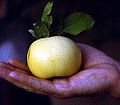- Malus sieversii
-
Malus sieversii 
A Malus sieversii fruit Conservation status Scientific classification Kingdom: Plantae (unranked): Angiosperms (unranked): Eudicots (unranked): Rosids Order: Rosales Family: Rosaceae Genus: Malus Species: M. sieversii Binomial name Malus sieversii
(Ledeb.) M.Roem.Synonyms Malus turkmenorum Juz. & Popov
Malus sieversii is a wild apple native to the mountains of Central Asia in southern Kazakhstan, eastern Uzbekistan, Kyrgyzstan, Tajikistan, Northern Afghanistan and Xinjiang, China. It has recently been shown to be the sole ancestor of most cultivars of the domesticated apple (Malus domestica). It was first described (as Pyrus sieversii) in 1833 by Carl Friedrich von Ledebour, a German naturalist who saw them growing in the Altai Mountains.
It is a deciduous tree growing to 5-12 m tall, very similar in appearance to the domestic apple. Its fruit is the largest of any species of Malus, up to 7 cm diameter, equal in size to many modern apple cultivars. Unlike domesticated varieties its leaves go red in autumn: 62.2% of the trees in the wild do this compared to only 2.8% of the 2170 English cultivated varieties.[2] The species is now considered vulnerable to extinction.
Contents
History and importance
For many years, there was a debate about whether M. domestica evolved from chance hybridization among various wild species. Recent DNA analysis has indicated, however, that the hybridization theory is probably false.[3] Instead, it appears that a single species still growing in the Ili Valley, on the northern slopes of the Tien Shan mountains at the border of northwest China and Kazakhstan, is the progenitor of the apples we eat today. Leaves taken from trees in this area were analyzed for DNA composition, which showed them all to belong to the species M. sieversii, with some genetic sequences common to M. domestica.
However, another recent DNA analysis[4] showed that Malus sylvestris has also contributed to the genome of M. domestica. A third species that has been thought to have made contributions to the genome of the domestic apples is Malus baccata, but there is no hard evidence for this in older apple cultivars.
Almaty, the largest city in Kazakhstan, and long-time capital, derives its name from the Kazakh word for 'apple' (алма), and is often translated as "full of apples" (the region surrounding Almaty is home to forests of Malus sieversii); alma is also 'apple' in other Turkic languages, as well as in Hungarian. The Soviet-era name, Alma-Ata, is Kazakh for "Father of Apples."
Renewed interest
These and other Malus species have been used in some recent breeding programmes to develop apples suitable for growing in climates unsuitable for M. domestica, mainly for increased cold tolerance.[5]
Malus sieversii has recently been cultivated by the United States Agricultural Research Service, in hopes of finding genetic information of value in the breeding of the modern apple plant. Some, but not all, of the resulting trees show unusual disease resistance. The variation in their response to disease on an individual basis is, itself, a sign of how much more genetically diverse they are than their domesticated descendants.
References
- ^ Participants of the FFI/IUCN SSC Central Asian regional tree Red Listing workshop, Bishkek, Kyrgyzstan (11-13 July 2006) (2007). "Malus sieversii". IUCN Red List of Threatened Species. Version 2.3. International Union for Conservation of Nature. http://www.iucnredlist.org/apps/redlist/details/32363.
- ^ Archetti M. (2009). Evidence from the domestication of apple for the maintenance of autumn colours by coevolution. Proc Biol Sci. 276(1667):2575-80. doi:10.1098/rspb.2009.0355 PMID 19369261
- ^ Velasco R., Zharkikh A., Affourtit J. et al., The genome of the domesticated apple (Malus x domestica Borkh.) Nature Genetics, 2010, 42, 10, 833
- ^ Coart, E., Van Glabeke, S., De Loose, M., Larsen, A.S., Roldán-Ruiz, I. 2006. Chloroplast diversity in the genus Malus: new insights into the relationship between the European wild apple (Malus sylvestris (L.) Mill.) and the domesticated apple (Malus domestica Borkh.). Mol. Ecol. 15(8): 2171-82.
- ^ Sauer, Jonathan D. (1993). Historical Geography of Crop Plants: A Select Roster. CRC Press. pp. 109. ISBN 0849389011.
- World Conservation Monitoring Centre (1998). Malus sieversii. 2006. IUCN Red List of Threatened Species. IUCN 2006. www.iucnredlist.org. Retrieved on 11 May 2006. Listed as Vulnerable (VU B1+2c v2.3)
External links
- Wild apples in Kazakhstan: 1995 and 1996 US Agricultural Research Service expeditions
- http://www.findarticles.com/p/articles/mi_m1134/is_8_110/ai_79051530
Categories:- IUCN Red List vulnerable species
- Apples
- Flora of Kyrgyzstan
- Flora of Kazakhstan
- Flora of Uzbekistan
- Flora of Afghanistan
- Flora of Xinjiang
- Flora of Tajikistan
- Vulnerable plants
Wikimedia Foundation. 2010.



